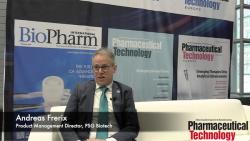
OR WAIT null SECS
- About Us
- Advertise
- Editorial Information
- Contact Us
- Do Not Sell My Personal Information
- Privacy Policy
- Terms and Conditions
© 2024 MJH Life Sciences™ and BioPharm International. All rights reserved.
From the Editor: The Industry's Disposition Toward Disposables
Disposables are no longer a mistrusted new technology; they're seen as a potential solution to everyday problems.
One of the first things most people learn about biopharmaceutical manufacturing is that change happens slowly. The industry's willingness to evaluate and adopt disposable manufacturing technologies, however, shows that the slow pace of change is the result not of obstinance but of caution.
Laura Bush
A February 15 live webcast on disposables, hosted by BioPharm International and Pharmaceutical Technology magazines, made that clear, through the information presented and the audience's participation.
The first speaker, Eric Langer of BioPlan Associates, presented results of his firm's recent industry survey. The responses in 2006, in comparison with those from the previous year, signal a significant change. "The industry is demonstrably more comfortable with disposable technologies," Langer said.
When asked how they could avoid capacity constraints, for example, 37% named cost-effective disposables, compared to only 24% in 2005. In other words, disposables are no longer a mistrusted new technology: they're a potential solution to everyday problems.
Even more significant was the number of people (almost 30%) who said they want better-performing disposables. This signals even more clearly that they have moved to another step in the process, because it is not until one is familiar with a technology that one begins to ask it to do more. (Only after you use an iPod for a year will you ask for one that holds more songs).
Another important shift is that the industry is broadening its application of single-use technologies. Although the top four applications that users cited in BioPlan's survey are still related to filtration, which is inherently disposable, 60% of respondents now say they are using disposable bioreactors, versus only 21% in 2005. Daniella Kranjac of Wave Biotech, a manufacturer of disposable bioreactors, said this was a far cry from the reaction her company received almost a decade ago when they first introduced the technology. "Frankly, we were laughed at," she said. No longer.
The audience's questions reflected a similar level of acceptance. More than 400 people signed up to watch the event, and participants submitted more than 80 questions. As expected, many questions (11) related to extractables and leachables, which mirrors the results of Langer's survey, where this appeared as the number one reason users cited for restricting their use of disposables. Regulatory concerns, another major impediment to adopting any new biomanufacturing technology, was cited 8 times, and 18 questions about validation came in—about what kinds of studies must be done, how long the studies take, etc.
But on the other hand, a whopping 23 questions came in about specific applications. In other words, these listeners are ready and willing to adopt the technology if it suits their product and process needs. Add to this the 10 questions about product performance and the 18 questions about scale and size limitations, and you see a significant percentage asking the kinds of questions that indicate the buyer is willing, but trying to make the right choice.
So the biopharmaceutical industry, known for its historical caution in adopting manufacturing changes, is moving forward steadily in evaluating single-use technologies. No one is rushing in headlong, nor should they be. What the disposables example shows, however, is that the industry's approach is not aversion to change; rather, it's a sensible and careful consideration from the point of view of ensuring product safety, managing regulatory concerns, and evaluating the relationship between costs and benefits.
Laura Bush is the editor in chief of BioPharm International, lbush@advanstar.com



